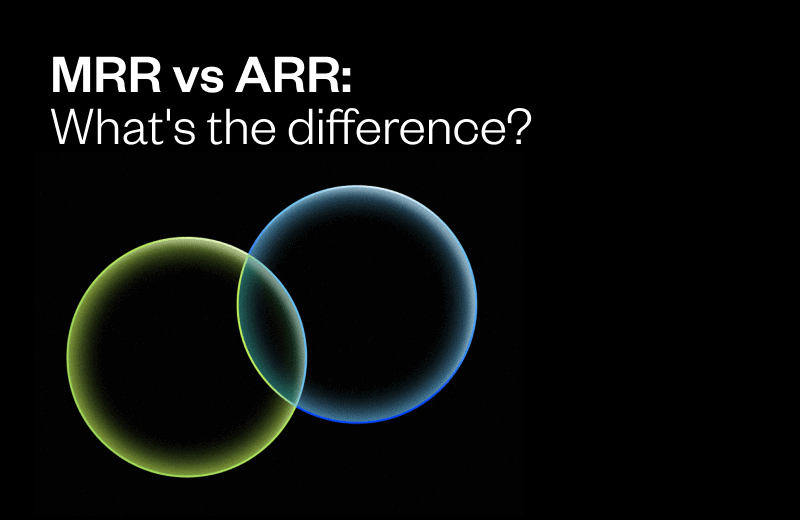Customer success in SaaS has gone from a buzzword to the weapon of choice to increase conversions, improve customer happiness, and decrease churn for recurring revenue businesses. It’s no wonder customer success has quickly moved from optional to mandatory for SaaS companies in a competitive marketplace.
Adobe Sign’s (formally know as EchoSign) founder and former CEO Jason Lemkin explains, “Client Success owns the customer from point of inception (sometimes pre-close) all the way through the entire life and lifecycle of the customer. Sales closes the customer, and Customer (or Client) Success takes it from there.”
If you didn’t see the rise of client or customer success management (CSM) in SaaS coming, this post is your chance to get caught up. Already in the know? You’ll find plenty of gems to make your customer success team even better.
In this post, you will learn:
- What SaaS customer success is
- How customer success leads to more recurring revenue
- How to make customer success part of your company’s DNA
- Metrics to measure customer success
- The future of customer success
What is Customer Success in SaaS?
One of the most important things to understand about customer success is what it is not. It is not taking your sales or tech support team and renaming it “customer success.”
It starts by recognizing that your customers need more than documentation, automated onboarding flows, and drip email campaigns for you to live up to the promises made on your website and landing pages.
According to SaaS customer success expert Lincoln Murphy, at its most basic level, customer success starts out as an aim, not a department of people or a group of processes – though those things are equally important and we’ll discuss them shortly.

Salesforce is credited with coining the term customer success, and they stand out in CSM by deeply understanding the desired outcomes of their customers. While Salesforce lacks in simplicity and a modern user experience, (if you have ever used Salesforce, you know what I’m talking about,) their focus on customer success has made them the leader in CRM software.
In 2014 Salesforce made headlines with a major strategic shift from a sales-driven CRM company to one focused on long-term customer success.
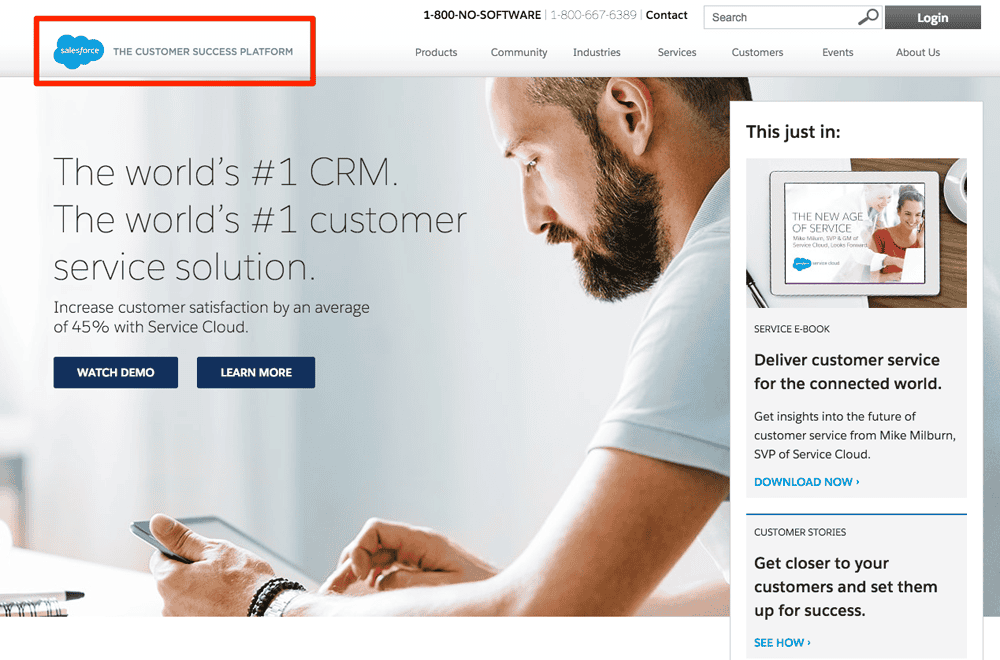
Part of their effectiveness has come from a clear distinction between customer success and customer service:
“Your front-line folks [customer service] should focus on solving any issues that pop up in a timely and effective manner. Customer success, however, should be a proactive movement by account management and leadership. The end goal is to think long-term.”
So what exactly is involved with customer success?
- Making sure new signups successfully set up their account and see the value of your product
- Converting trial users into paying customers
- Ensuring paying customers are getting the most out of your product or service and remain happy, paying customers and brand advocates
- Gaining real life feedback and use cases to guide your product roadmap
- Identifying and engaging at-risk accounts to prevent churn
- And everything in between…
Below is a general overview of how the customer success pipeline looks within a SaaS and other recurring revenue companies.

Ok, now that we’ve covered the basics, let’s get to the more important information . . .
How does customer success lead to more recurring revenue?
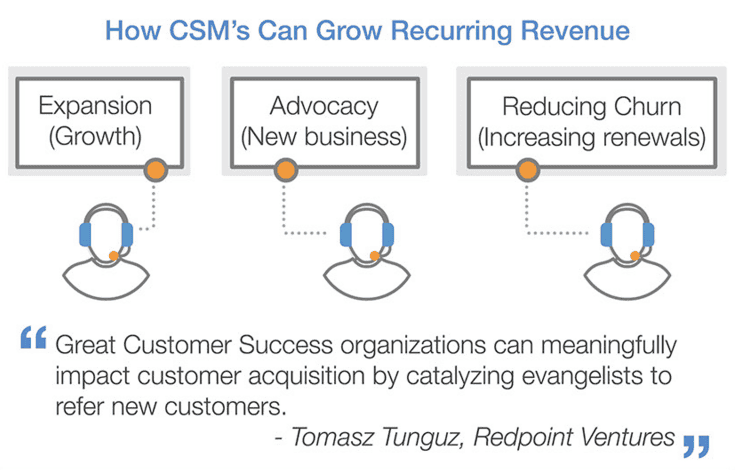
Better onboarding = increase in paid conversions
“The onboarding period is, for a business, perhaps the most critical time in a SaaS customer’s life.” Alex Turnbull, CEO of Groove.
It’s critical because those initial sessions determine if the customer will see value in your product. If they don’t, the user will likely leave and never return.
Onboarding is a key metric Groove uses to measure customer success. When a user signs up they immediately receive a series of onboarding prompts in their Groove inbox.

Groove found free users who complete those onboarding prompts within 24 hours of signup are 80% more likely to convert to paid users. Thus, the 24 hour mark has become a Groove metric for early customer success.
In the metrics section below, we will shed more light on analyzing onboarding workflows and engagement, identifying pain points, and optimizing your onboarding experiences.
Reduce churn, increase customer lifetime value (CLV)
For recurring revenue businesses, most of your revenue comes after the initial sale.

According to serial entrepreneur turned VC David Skok, “as you grow, churn is compounded because it becomes harder to replace churn with new users as you scale.”
How do you reduce churn? Keep your customers happy. Make sure your users are receiving their desired outcome from your product or service (remember the definition of customer success hinges on this).
Hubspot was able to retain 33% of previously unhappy customers by utilizing their proprietary “Customer Happiness Index” (CHI). The CHI calculation is based on several factors, including how frequently customers blog and track leads through HubSpot, whether they run email and conversion campaigns, if they engage in social media, and more.
Based on CHI scores and Hubspot’s historical data (from thousands of customers over many years), the company implemented a concierge onboarding process to improve customer success.
When a customer signs up with Hubspot, they are assigned an “Inbound Marketing Consultant.” This Hubspot consultant not only walks the customer through initial use of the software they also work together throughout the first few months of using Hubspot.
To help achieve the highest CHI scores possible, new customers also get a crash course in inbound marketing. To make sure each customer gets the most out of their subscription, Hubspot gives every customer a monthly account review.
Not only did the CHI methodology reduce churn, customers who implement inbound marketing according to HubSpot’s guidelines “get double digit increases in leads every month.” Those customers are receiving their desired outcomes from Hubspot’s products. See how we’ve gone full circle here?
Decreasing churn can have a huge effect on overall revenue. As you can see in the graph below, it can make the difference between MRR (monthly recurring revenue) of $700,000 and one of $2,700,000 with an adjustment of 8%.

Customers become champions for your product
When you’re effective at customer success you have happy customers who refer other customers. Those referrals are your best leads.
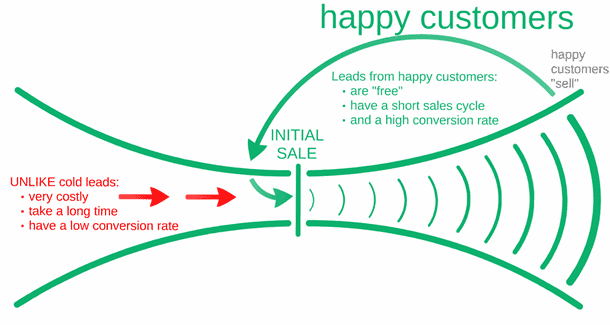
Jason Lemkin not only identified this as the most important concept for Adobe Sign, he went one step further and looked at second order revenue:
“This consists of two parts – customers of your product (the champions for your product) changing companies and bringing your product on board with the new company. The other is word of mouth revenue. This system relies on customer success.”
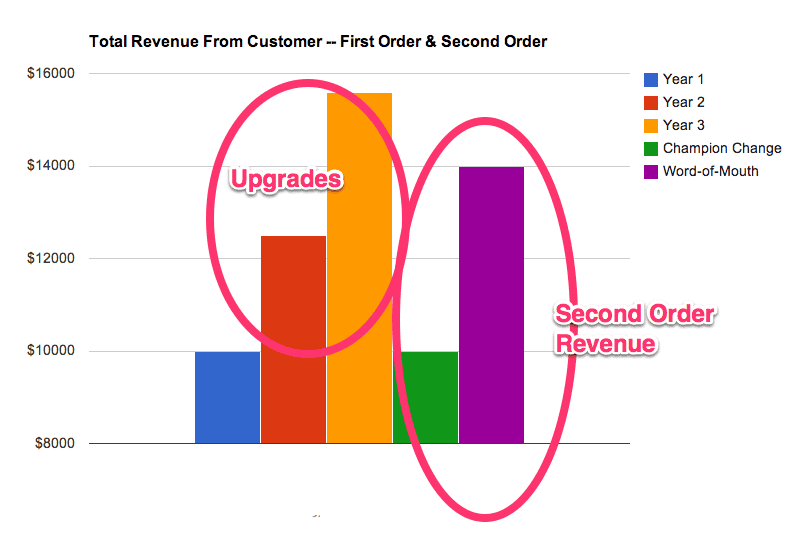
Knowing why customer success is important doesn’t automatically translate to knowing how to successfully set it up in your own company. Which takes us to . . .
How to make customer success part of your company’s DNA

It starts at the top
Whether you’re just starting out or you are realigning your current customer success team, Murphy stipulates, “Customer success needs to be part of the DNA. This comes back to organizational culture, which is driven at the executive level.”
Salesforce calls this understanding the “Aha Moment”: “In order for an organization to truly deliver Customer Success it cannot just come from one department … it must be a mindset that permeates throughout the entire organization.”
As illustrated below, the customer journey provides many opportunities for customers to churn.

Since customer success is on the front lines talking to customers from pre-close through renewal, they help bridge the gap by consulting with each department, from marketing to product management.
Once you have customer success ingrained in company culture, it is key for upper management to ensure that all departments are working with customer success (rather than operating in silos).
A SaaS company that experiences growth via effective customer success must continue to remain focused on CSM across all departments as the business scales and keep the channels of communication open.
Have a dedicated customer success team & hire specifically for it
We’ve already covered the idea that a customer success team is not simply renaming your sales or tech support team.
You need to have a dedicated CSM team. Unless you have dedicated people thinking about customer success all the time, it will not happen.
“Start with a clearly defined goal, get the company on board and believing in this goal, and then don’t compromise on the hiring process,” advises Dennis Hennessey, Senior Customer Success Manager at Nasuni Corporation.
Unbounce hired for customer success early on. Ryan Engley, Director of Customer Success at Unbounce, was the third employee hired on with the company. He credits CEO Rick Perreault with recognizing (and pushing) the importance of customer success from day one.
Unbounce has harnessed the power of customer success so well, they doubled their MRR twice within their first three years of business. Rapid growth has been a constant for the company (see the graph below), and they ended 2014 with over $7M in revenue!
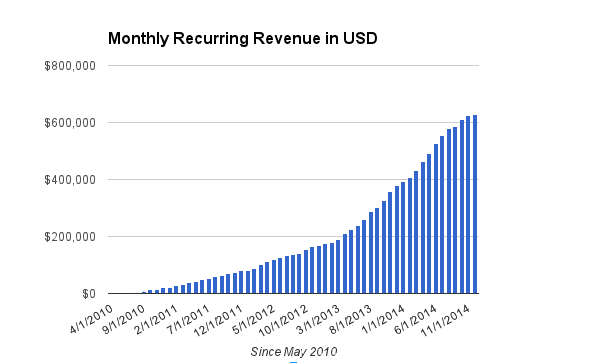
A progression is natural, but by the time you’ve reached $2M in Annual Recurring Revenue (ARR) you need to hire a Customer Success Manager. Jason Lemkin actually advises hiring a CSM for every $2M in ARR.
Once you have your rockstar customer success team and manager in place, it is important to tie their compensation and bonuses to customer success metrics (we’ll cover those shortly). According to Slack CMO Bill Macaitis, setting up the right long-term metrics will incentivize teams to deliver good experiences.
Help me help you (but learn to say no)

This isn’t just about slipping in a Jerry Maguire reference (but it’s a fun bonus). Customer success needs to be implemented in a way that is positive for BOTH your company and customer.
Unbounce CEO Rick Perreault speaks candidly about how this issue showed up in the company’s early days:
“It’s especially tough when you’re bootstrapping, and you’re Ramen profitable, and you start getting recognized brands calling you up saying hey, if you just build this feature, we’ll buy. It’s so tempting, but it’s also a huge distraction. We fumbled around for two years trying to do everything for everyone, and it took a lot of discipline to get focused.”
Lincoln Murphy explains, “It seems odd to have to say this out loud, but if you do whatever it takes to please the customer (like never saying “no” to customization requests), but you do so to the detriment of your company, this is not Customer Success.”
The takeaway: As you dive deeper into customer success, it is important to establish policies for when and how to consider a feature request versus simply saying “No.” This includes clarity into the company’s core customer and product vision/roadmap. Help your customers get the most out of the product your company built, but do not let them steer you away from core priorities and goals that will have an even bigger impact.
Metrics to measure customer success

Customer success metrics can really be a blog post all on its own. We won’t do a deep dive into metrics, but we do want to identify some customer success metrics you should be monitoring. Every business is different, so take some time to think about your business and the metrics that matter the most.
Onboarding Engagement: Onboarding is your first chance to engage a user and set them on a path to becoming a paid customer. If they find your product too difficult to achieve their goals, they are likely to abandon ship and never return. You can use products like KISSmetrics to analyze signup workflows and engagement to identify pain points and optimize your onboarding experiences.
- Core tasks completion Determine the core tasks that need to be completed to get the most out of your product. Do they need to create a task, upload a file, invite a team member? If users are getting lost in the onboarding funnel, how can you make completing those tasks more intuitive?
- First session length How long should it take someone to get up and running? If it is 12 minutes, but the average first session length is 3 minutes, you might have a problem.
- Returning sessions How many visitors sign up and then don’t log back in for days, weeks, or ever? You can use tools like Intercom to automatically communicate with these users and offer assistance to bring them back.
Trial to Paid Conversion Rate: What percent of your trials are converting to paid? Less than ideal numbers mean there may be issues affecting your company’s health:
- Not bringing in the right customers to try your product
- Misalignment of website’s perceived value and product’s true value
- Poor onboarding or user experience (see above)
- Your product is priced too high
Have your customer success team try to talk to as many users as possible that sign up and do not convert to find out WHY they didn’t convert. Sometimes you can offer a solution to their problem and can bring them back, but at a minimum, you can learn a lot to help optimize future conversions.
Upgrades (Expansion MRR): Customer success generates “upsell opportunities and account upgrades through an understanding of the signals that suggest an account is a good candidate for expansion,” says Morgan Brown, former Head of Growth at Qualaroo.
In other words, happy, paying customers make ideal upsell candidates. Once a customer is fully engaged with your product and understands the value, they are more likely to upgrade for advanced features and functionality. They also are likely to be brand advocates championing your product to others. On average, brand advocates spend twice as much on your products and services than an average customer.
Customer Satisfaction: Customer success and customer satisfaction ratings go hand in hand. There are two easy metrics for this:
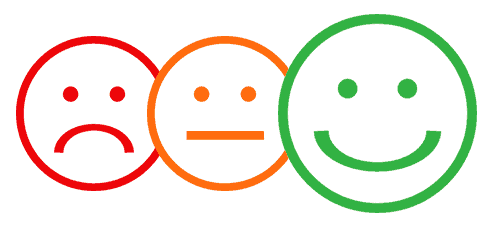
- Support Satisfaction Rating
If you have ever submitted a support ticket, you have likely received a follow up asking how satisfied you were with the response. This can be a qualitative rating, a simple thumbs up or thumbs down, or the infamous “sad, straight, or smiley face.” Gathering this feedback will let you quantify how happy customers are with the support they receive. At Maxio, we are proud to have a 98% satisfaction rating! - Net Promoter Score (NPS)
Your company’s NPS is the ultimate gauge of customer satisfaction and separates the promoters from the detractors. In addition, you get real, honest feedback that can help guide your company’s product roadmap and vision. Routinely send NPS surveys every 3, 6, or 12 months to know how your score is progressing. An improved NPS score indicates your product and business are performing better, and you’re becoming more valuable to your customers. At Maxio, we used Delighted for our NPS surveys and have been very happy with their product.
Churn: Understanding and reducing churn can have a dramatic impact on a company’s long-term health. Sure, people are going to churn for various reasons like their business didn’t work out, but there are other times churn is preventable. Groove speaks to churn quite simply — “If customers are leaving, then we’re not achieving customer success.”
When customer success is engaging with at-risk accounts and keeping the general customer base happy, you are bound to reap the benefits through reduced churn.
What’s Next for SaaS Customer Success?
Based on where CSM has been and is now, here are some things we see in the future for customer success:
The Sooner, The Better
Murphy predicts “hyper-growth startups will accelerate their adoption of customer success as part of their DNA.”
While we have already started to see this in recent startups, customer success will be baked into the company’s culture from day one. As the marketplace comes more saturated, existing companies will need to adapt to keep their edge. The sooner you invest in customer success, the better.
Customer Success Joins Management
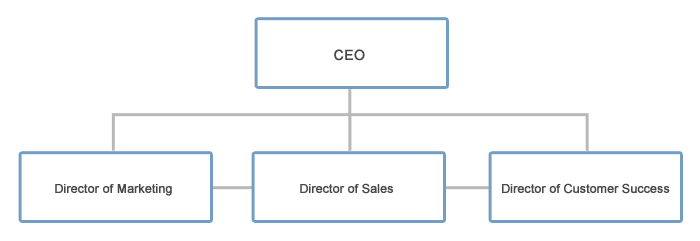
The executive team of the future will have a Director of Marketing, Director of Sales, and Director of Customer Success. Most notably, all three positions will be of equal importance and work together on a regular basis.
Growth Hacking Spreads Into Customer Success
Growth hacking is a term/buzzword that is generally associated with marketing. But Sean Ellis, who coined the term “growth hacking,” defines a growth hacker as “a person whose true north is growth.” This is because they utilize analytical thinking, product engineering and creativity to significantly increase their company’s core metric(s).
We’ve already began to see a crossover with growth hacking and customer success, and this will continue to increase in the future. Growth hacking and customer success both share the goals of user engagement, churn reduction, and increasing CLTV. Sarah E. Brown calls this crossover success hacking.
Tomasz Tunguz said it best: “I’m excited about the innovations to come in customer success in the next few years. Companies at the forefront of customer success will benefit disproportionately from their investment with faster growth, happier customers and better capital efficiency.”
If it wasn’t clear to you before reading this post, hopefully it is now: customer success in SaaS is here to stay and it needs to be an integral part of your own SaaS company. When customer success is part of your SaaS business’ DNA, you will reap the benefits through increased MRR, decreased churn, and loyal brand advocates.


